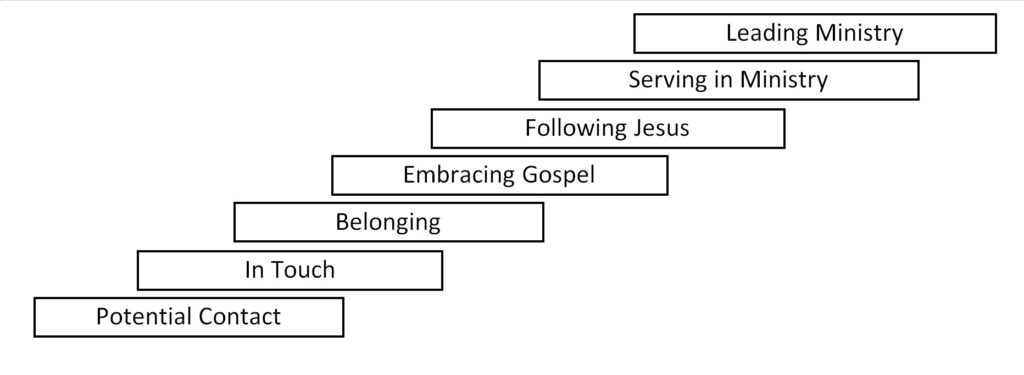How Does Pathways Work?
How does Pathways Work?
Mission Focus
Pathways thinking begins by identifying the people within the span of influence of your church that you might meaningfully engage. In church planting literature, these people are sometimes referred to as a ‘mission focus group’ – ie the people with whom you’ll focus your primary attention in mission. Once you’re identified a mission focus group, Pathways encourages you to think about the following seven stages that map the journey from being someone who doesn’t know Jesus or his followers, to being a person who’s leading others in mission.
Once you’re identified a mission focus group, Pathways encourages you to think about the following seven stages that map the journey from being someone who doesn’t know Jesus or his followers, to being a person who’s leading others in ministry.
7 Stages:

Potential Contact
In Pathways parlance, we say that people have ‘potential for contact’ when they’re only an introduction away from connecting with someone from the church. That introduction could come by finding a phone number in a directory, meeting in the course of daily life, or visiting a website.
In Touch
Once that contact is made with someone from church, a person is ‘in touch’ with the church (even if they may not yet know it). It may be that they’ve begun a friendship with a church member, or had a meeting with the minister to arrange their wedding. Whichever way, there’s someone at church who knows their name and is interested enough to nurture the relationship.
Belonging
A person ‘in touch’ with a local church is only an invitation away from beginning to feel like they ‘belong’ with the church community. This means that they fairly regularly participate in a group that includes a number of Christians. This is often where their felt needs are met – be it a playgroup, a marriage support group or an after-school kids-club.
Embracing the Gospel
People who feel some sense of belonging are only an invitation away from beginning to consider the claims of Jesus Christ. We call this stage ‘Embracing the Gospel’. Here people come to understand the good news that God loves them, that God has made a way for them to be adopted as his children through Jesus. This could happen through traditional means such as the confirmation class, a process-evangelism course like Alpha, or a discovery Bible study.
Following Jesus
People who’ve embraced the gospel can naturally be invited to environments that help them shape their life and values to the teaching and example of Jesus. The ‘following Jesus’ stage is about helping believers to embed habits that will lead to a lifestyle of discipleship.
Following Jesus activities might be a Bible class or a prayer triplet. It’s almost certainly the weekend worship service.
Serving in Ministry
Serving in ministry activities help and support people to contribute to the ministry of Jesus and his church. These include processes like ministry team training and giftedness discovery courses.
Leading Ministry
The final stage in the pathway is Leading ministry and includes activities like the church board or leadership community. Some may never move to this stage – leadership is not everyone’s cup of tea.
You can see the stages laid out in a helpful matrix here.
